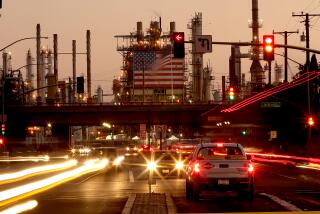Pollution Rules Don’t Deter Paint Plant
- Share via
Adding a new chapter to the debate over California’s supposedly too-tough-for-business regulatory environment, Georgia-based Gulfstream Aerospace Corp. not only formally opened a new aircraft paint plant in Long Beach on Tuesday, but its executives were boasting about the regulatory hoops they had to jump through to make it happen.
“These requirements were the most difficult requirements to meet,” said Gulfstream President and Chief Operating Officer Jim Johnson, who showed off the facility to Long Beach Mayor Beverly O’Neill and others during a ceremony Tuesday. “In the end, we met all the standards and came up with a better paint job because the air is purer, the water is purer.”
Although the facility represents only 80 jobs--roughly 10% of Gulfstream’s work force in Long Beach--it seemed to take on a significance beyond its impact on the local economy, mostly because of the difficulties involved with using paint.
Tough air and water regulations had proved to be an obstacle to other aircraft manufacturers in Southern California, who moved operations out of state.
When Gulfstream decided it needed at least twice as much space to paint its planes, Texas, Georgia, South Carolina and Oklahoma, all with considerably less stringent requirements, were considered, Johnson said.
Long Beach officials thought they were in danger of losing the entire Gulfstream operation. Gulfstream had been building its planes in Savannah, flying them to Long Beach to complete the interiors, then returning them to Georgia to be painted.
“Gulfstream had long heard it was impossible to do this type of project in Southern California,” said Larry Watkins, a supervisor with the South Coast Air Quality Management District who helps businesses clear hurdles. “They put their nose to the grindstone, got first-class people with first-class technology, and this is the state-of-the-art facility in the country.”
Jacqueline Ayers, a Gulfstream consultant who helped the company clear the regulatory hurdles, said the firm combined two or three existing technologies into a unique facility that cost $8.5 million to build.
The planes are painted in a series of three hangars. Clean air is introduced into the structures, captured, cleaned and then recirculated in a process requiring massive air-flow ducts, huge fans and long sheets of polyester filters. The system is somewhat similar in principle to the way household vacuum cleaners work, only instead of picking up dirt from a carpet, the system pulls tiny particles from the air.
Along with the air filtration system, a water filtration system purifies runoff water and allows Gulfstream to use methylene chloride, a toxic compound targeted by environmental laws, to strip aircraft.
Watkins hopes other manufacturers follow suit.
“Gulfstream was the first to jump into the Southern California area, which has needed a paint facility like this for a long time,” Watkins said. “Everybody else moved out of the area for one reason or the other.”
More to Read
Inside the business of entertainment
The Wide Shot brings you news, analysis and insights on everything from streaming wars to production — and what it all means for the future.
You may occasionally receive promotional content from the Los Angeles Times.










